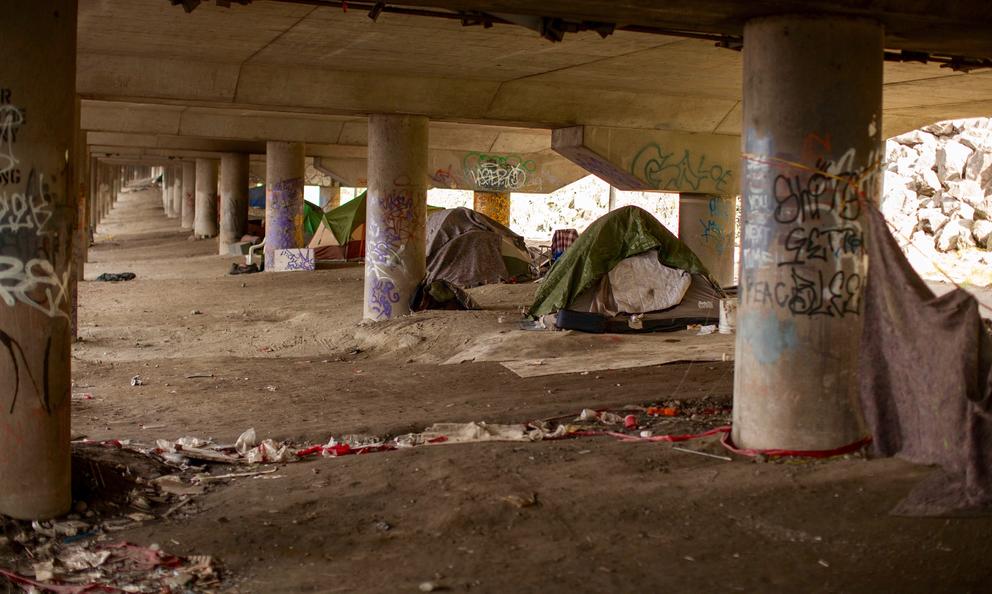The shoe has dropped for the area beneath I-5 and the East Duwamish Greenbelt, home to hundreds of people and unofficially known as the Jungle. Following two weeks of “intensive” outreach that is just about to start, its residents will be asked to leave.
It’s part of a coordinated and controversial effort between Seattle and the state of Washington, called the Joint Action Plan, to close the book on the space, a pot at the end of the rainbow sought by officials for decades.
Space beneath the highway, loud from traffic rattling overhead, has essentially been condemned as unfit for human habitation: A recent report from the state, city and county tore into the conditions as unsanitary and unsafe. The January deaths of Jeanine Zapata and James Q. Tran — shot as Mayor Ed Murray publicly begged collaboration on the homelessness state of emergency — widened the target on the Jungle’s back.
The message from the Mayor’s Office has, in fact, been consistent: The Jungle is unsafe. It is that message that has apparently driven the urgency to shut it down we’re seeing now.
But pushback has been just as consistent from those who, while supportive of keeping people safe, believe the fast timeline is unrealistic and the services lacking.
In the plan’s ideal form, those who now live in the greenbelt will accept “meaningful” offers of services and move into shelter. Crews, meanwhile, will clean out “major health hazards” which, according to a joint statement from the offices of Mayor Murray and Gov. Jay Inslee, include human waste, garbage and fire hazards like brush. Roads and paths will be hacked for improved access to the area. In addition to the roads, crews will add lights, all part of an effort to make the area less intimidating and threatening.
As Crosscut reported recently, Scott Lindsay, public safety advisor to Murray, has been making the rounds among council members since at least late April, briefing some of them on the plan. In those early discussions, the most contentious piece, a fence to keep people out, had been re-labeled as a series of “gates.” Councilmember Lorena Gonzalez had concerns at the time. “I have significant questions about the gates,” she said. “They ostensibly create a fence.”
In Tuesday’s public announcement, there was little direct mention of a fence or gates, but instead plans to “develop proposals for utilizing and managing access to segments of the I-5 East Duwamish Greenbelt.” What that means, exactly, will be pursuant to the language of those proposals. But Dave McCormick of WSDOT said 20 percent of the budget to shut down the Jungle would be reserved for future recommendations from a consultant, which could include a fence. And based on the mayor’s strong belief that the space is unsafe, it’s certainly still a possibility, if not a likelihood.
Other lingering concerns have been the timing and sincerity of outreach.Gonzalez couldn’t immediately be reached for comment following the public announcement. But she said earlier, “You have to have real offers of real services to the folks currently living under the I-5. My expectation is every time an outreach worker makes contact with someone who lives there and offers voucher or a place in a shelter, that that option is a real option.”
Jason Johnson, the city's deputy director of the Human Services Department, said, “We believe there is some capacity in our existing shelter system,” adding that service providers “have a long history of being able to expand shelter access.” The expectation will be that shelters will be in emergency mode all the time.
Over the phone Tuesday, Councilmember Sally Bagshaw said, "I think the mayor and the governor were really careful with their public health response," referring to the emphasis on cleaning out hazardous material. But she expressed skepticism that moving people into temporary shelters, often open only 11 hours, will be sufficient. "If anybody had asked me what more we could have done, I’d have said, Let us find a building where we can get people in with cots and showers and running water with at least the assumption that they’ll move on to permanent housing."
Regarding the two weeks of outreach, Union Gospel Mission President Jeff Lilley, said that the outreach has actually been taking place for a long time and workers have already established trust. A city spokesperson said the stepped-up effort by the Mission is expected to begin next week.
One serious issue is that many people living on the streets have long ago decided against using shelters. The strict hours, long waits and restrictive rules can be disruptive to establishing a rhythm. And shelters that guarantee the three Ps — pets, partners and possessions — are lacking.
Funding for the effort will come out of the $7 million city's state of emergency allocation and the $1 million set aside by the state.
This story was updated at 2:45 p.m on Tuesday, May 17.



